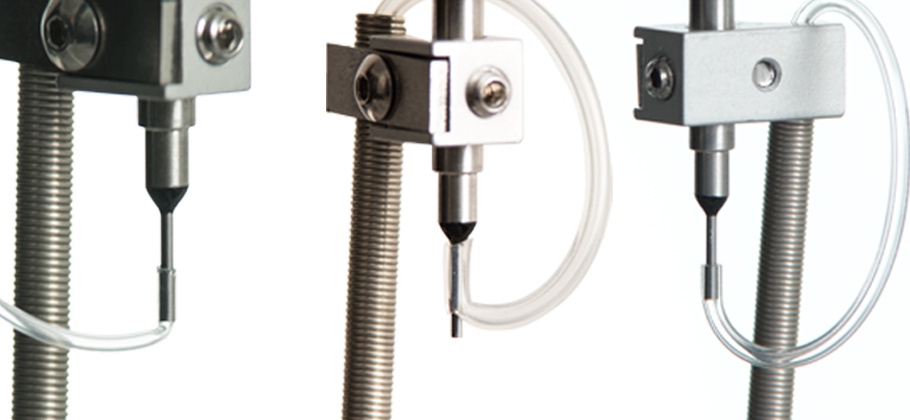Compromised patency often stems from blockages in the catheter, particularly the tip. Unfortunately, we can't see what's going on internally, making it extremely difficult to diagnose the root cause. As a result, we wanted to help identify what is happening at the tip of the catheter, where occlusions often occur, and what can be done to prevent them.
When dealing with vascular catheterization in mice and rats, the catheter tip must be positioned in the ideal location for what is considered optimal patency. When the tip is correctly placed, combined with proper maintenance, patency can extend for months. Learn more about ideal catheter tip placement.
While catheter tip placement is critical, the technique while maintaining catheters matters too; specifically the positive pressure technique. Blood in the tip of a catheter can clot and form blockages, preventing sampling or infusion. Best case, an intervention is needed to clear the clot; worst case, the animal must be pulled off the study.
But where and how do these blockages typically occur, and what can be done to help prevent them? We ran a benchtop study to find out. What happens at catheter tips just may surprise you.
Rat Catheters (3Fr)
Test 1: Traditionally, a hemostat is used to clamp the externalized catheter and the catheter sealed with a plug. When the hemostat is released, blood pulls back into the catheter as the catheter springs back to its normal shape. With a 3Fr rat catheter this pull back is 6mm which equates to about 1µl.
Test 2: We show the results when using an external port without positive pressure technique. These ports, such as the PinPorts™ used in Instech Vascular Access Buttons™, limit pullback to the volume vacated when the injector is removed from the port; this time, the pullback is 3mm which equates to about 0.5µl.
Test 3: We demonstrate the way to eliminate the pullback completely. If you apply slight pressure to the syringe plunger as you remove the injector from the port - known as positive pressure technique - you can avoid pullback at the catheter tip as the sterile flush or lock solution remains within the catheter. This technique is well known to ICU nurses who deal with central venous catheters but is not always practiced in laboratory animal research.
3Fr Rat Catheter Results
Test 1: Standard externalization with traditional technique - 6mm of blood in the catheter.
Test 2: Vascular Access Button™ without positive pressure technique - 3mm of blood in the catheter.
Test 3: VAB™ with positive pressure technique - no blood in the catheter.
Mouse Catheters (1Fr)
While positive pressure technique can improve patency of rat catheters, it can mean the difference between success and failure with mouse catheters.
Test 1: A 1Fr mouse catheter, typically used to access the mouse carotid artery or femoral vein, has a volume per cm one-tenth that of a rat catheter. As you’ll see in the video, the results are dramatic. Even with a VAB™, blood can be pulled back 50mm into the catheter if positive pressure technique is not used.
Test 2: Using the same setup as Test 1 with the 1Fr catheter and a VAB™, we applied the positive pressure technique and were again able to eliminate blood pullback within the catheter.
1Fr Mouse Catheter Results
Test 1: VAB™ without positive pressure technique - 50mm
Test 2: VAB™ with positive pressure technique - 0mm
A researcher reported anecdotally that the positive pressure technique changed the success rate of mouse carotid artery catheterizations from 25% to 80%.
Summary
Catheter blockages can have a negative impact on sampling and infusion studies requiring more animals than necessary. The positive pressure technique is difficult, if not impossible, when catheters are clamped with hemostats and closed with plugs. The positive pressure technique may have been one of the factors that contributed to the 5x increase in patency of mouse jugular vein catheters in a study by Charles River focusing on standard exteriorizations versus transcutaneous access buttons.
Nevertheless, our tests have shed some light on what happens beneath the surface and amplified the importance of using a Vascular Access Button™ in combination with a solid positive pressure technique.
Extended patency is not only possible but can be expected using techniques and considerations such as the ones above. Learn more about other key factors that influence patency in our post Five Keys to Patency.
Successful, patent vascular access and catheterizations also require a skilled surgeon. We now offer protocols, training, and education programs for rodent microsurgery. To learn more visit our training and education page.
Bonus Tips
To minimize the amount of lock solution that is infused into the animal, practice the technique on the benchtop using the exact catheter and equipment you will use in vivo before moving to a live animal.
With mice it is even important to use two part syringes that do not have rubber plungers as the compliance of the plunger can pull blood into the catheter after your finger is off the plunger.
